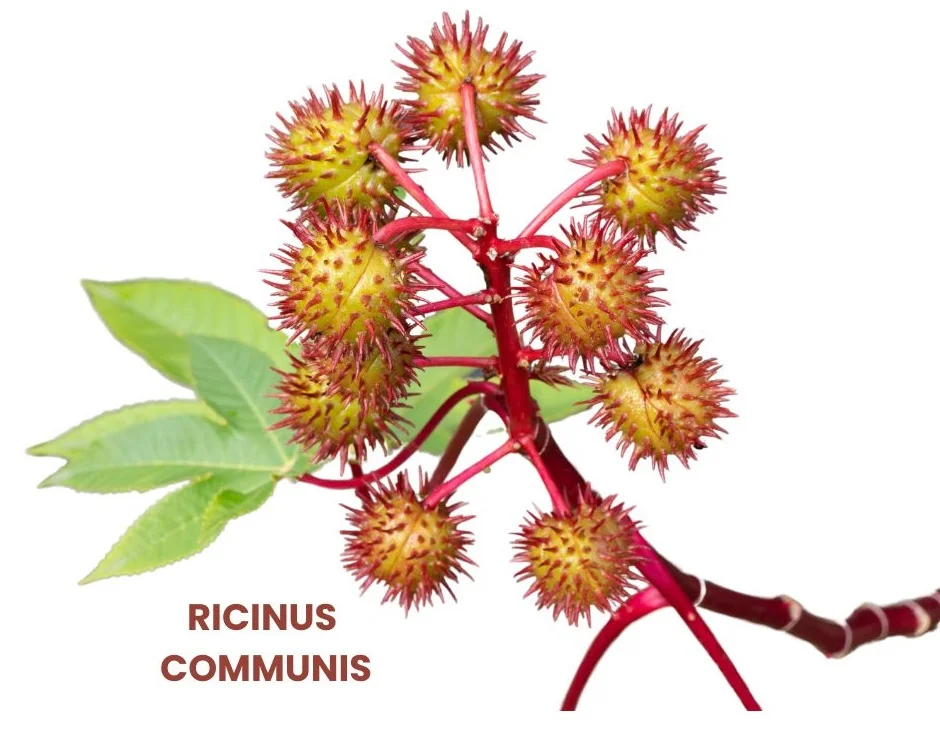Ricinus Communis, commonly known as the Castor-oil plant, is a homeopathic remedy with a pronounced effect on the gastrointestinal tract.
It is also known for increasing the quantity of milk in nursing women and alleviating symptoms such as vomiting, purging, languor, and weakness.

Table of Contents
ToggleSOURCE INFORMATION
Scientific Classification
- Kingdom: Plantae
- Clade: Angiosperms
- Clade: Eudicots
- Order: Malpighiales
- Family: Euphorbiaceae
- Genus: Ricinus
- Species: R. communis
Origin
- Ricinus Communis is believed to have originated in the Mediterranean region, eastern Africa, and India.
- It is now widely cultivated in tropical and subtropical regions worldwide.
- The plant is known for its large, lobed leaves and its seeds, which contain the toxic compound ricin.
Historical Facts
- The castor-oil plant has been used for centuries in traditional medicine for its purgative and anti-inflammatory properties.
- Castor oil, derived from the seeds, has been employed in various cultures for its medicinal and industrial applications.
- In homeopathy, Ricinus Communis is recognized for its ability to stimulate lactation and treat severe gastrointestinal symptoms.
DRUG PATHOGENESIS
- Ricinus Communis primarily affects the gastrointestinal system, causing symptoms such as vomiting, diarrhea, and colic.
- It also acts on the nervous system, leading to vertigo, headaches, and weakness.
- Additionally, it is used to increase milk production in nursing women.
KEY CHARACTERISTICS
- Marked action on the gastrointestinal tract with vomiting and purging.
- Increases the quantity of milk in nursing women.
- Symptoms include languor, weakness, vertigo, and headaches.
- Rice-water stools with cramps and chilliness.
- Emaciation and somnolence.
DETAILED ORGAN SYMPTOMS
HEAD
- Vertigo: Dizziness and a sensation of spinning.
- Occipital pain: Headache located at the back of the head.
- Congestive symptoms: Feelings of pressure and fullness in the head.
- Buzzing in ears: Persistent noise in the ears.
- Pale face: A noticeable pallor of the facial skin.
- Twitching of mouth: Involuntary muscle movements around the mouth.
STOMACH
- Anorexia: Lack of appetite accompanied by great thirst.
- Burning in stomach: Intense burning sensation.
- Pyrosis: Heartburn.
- Nausea: A feeling of needing to vomit.
- Profuse vomiting: Severe and frequent vomiting.
- Sensitive pit of stomach: Pain and tenderness in the upper abdomen.
- Dry mouth: Lack of saliva, leading to dryness.
ABDOMEN
- Rumbling: Noise and movement in the intestines.
- Contraction of recti muscles: Involuntary tightening of the abdominal muscles.
- Colic: Severe abdominal pain.
- Incessant diarrhea: Continuous, loose bowel movements.
- Rice-water stools: Watery stools resembling the water used to cook rice, often associated with cholera.
- Cramps and chilliness: Muscle cramps accompanied by a feeling of cold.
STOOL
- Loose and incessant: Frequent, watery bowel movements.
- Painless but with muscle cramps: Diarrhea without pain in the intestines but with cramping in the extremities.
- Inflamed anus: Redness and swelling around the anus.
- Green, slimy, and bloody stools: Bowel movements that are green, mucous-filled, and possibly mixed with blood.
- Fever, emaciation, somnolence: Fever, weight loss, and excessive sleepiness.
MODALITIES
- Worse: With eating, moving about.
- Better: Rest, applying hot poultices.
WHAT ARE MODALITIES IN HOMOEOPATHY?
RELATIONSHIP WITH OTHER DRUGS
- Compare with: Resorcin (used for summer complaints with vomiting and destroys germs causing putrefaction), Cholos terrapina (relieves muscle cramps), Arsenicum album (for similar gastrointestinal symptoms), Veratrum album (for severe diarrhea and vomiting).
DOSE
- Potency: Typically used in the third potency. For increasing the flow of milk, five drops every four hours, and a poultice of the leaves can also be applied locally.
Frequently Asked Questions (FAQs)
What conditions can Ricinus Communis treat?
- It treats severe gastrointestinal symptoms such as vomiting, diarrhea, and colic.
- It is also effective in increasing milk production in nursing women.
How should Ricinus Communis be administered?
- It is generally administered in the third potency, five drops every four hours for increasing milk flow.
- For gastrointestinal issues, follow the dosage prescribed by a homeopathic practitioner.
Are there any side effects associated with Ricinus Communis?
- When used in homeopathic potencies and under the guidance of a practitioner, it is generally safe.
- However, avoid contact with the seeds and raw plant due to its toxic properties.
Can Ricinus Communis be used for children?
- Yes, but only under the supervision of a homeopathic practitioner, especially for gastrointestinal issues.
What should be avoided while taking Ricinus Communis?
- Avoid excessive physical activity and ensure adequate hydration, especially if experiencing vomiting and diarrhea.
Glossary of Difficult Words
- Anorexia: Lack of appetite.
- Pyrosis: Heartburn.
- Somnolence: Sleepiness or drowsiness.
- Emaciation: Extreme weight loss and thinness due to severe illness.
- Rumbling: Noise made by the movement of gas in the intestines.
- Colic: Severe abdominal pain caused by spasms or obstruction.
- Congestive symptoms: Feelings of pressure and fullness in the head due to excess fluid.
- Poultice: A soft, moist mass of material, typically of plant material or flour, applied to the body to relieve soreness and inflammation.
This detailed drug picture of Ricinus Communis provides a comprehensive overview of its uses, effects, and administration, making it a valuable resource for both practitioners and patients.
